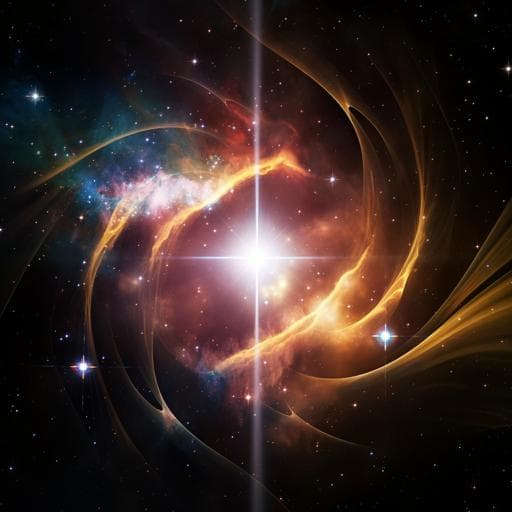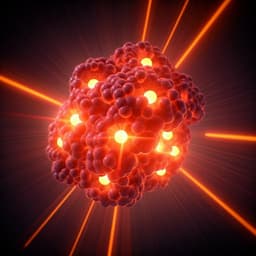
Physics
Observing quantum coherence from photons scattered in free-space
S. Sajeed and T. Jennewein
This groundbreaking research by Shihan Sajeed and Thomas Jennewein presents a pioneering method to transfer and recover quantum coherence from scattered photons, achieving an impressive 95% time-bin visibility across varied scattering angles. This innovation paves the way for non-line-of-sight quantum communication and improves low-light imaging contrast.
~3 min • Beginner • English
Introduction
The study investigates whether quantum coherence encoded in time-bin states can be reliably transferred via scattering surfaces and recovered from randomly scattered, non-line-of-sight photons in free-space. This capability would enable quantum communication without direct line-of-sight and enhance quantum sensing and imaging in noisy environments. Conventional free-space quantum channels primarily use polarization encoding, which is robust under clear line-of-sight but degrades under scattering and depends strongly on material and angle. Higher-order spatial mode encodings are also susceptible to wavefront distortion and are expected to vanish upon random scattering. Time-bin encoding is intrinsically robust to polarization and spatial distortions but has faced challenges in free-space due to atmospheric turbulence and multimode propagation. While field-widened (imaging) interferometers and mode-conversion approaches have enabled time-bin free-space links under line-of-sight, no prior work had demonstrated reliable transfer and recovery of time-bin coherence over non-line-of-sight, scattered channels. This work addresses that gap using an imaging time-bin interferometer with a single-photon-detector-array to recover coherence and image spatial modes simultaneously.
Literature Review
Prior free-space quantum communication experiments have predominantly used polarization encoding, which remains robust under line-of-sight conditions but suffers under scattering, with polarization visibility dependent on surface material and scattering angle, limiting usable angular ranges. Spatial mode encodings, while enabling higher-dimensional channels, are directly impacted by wavefront distortions and vanish upon random scattering. Time-bin encoding is widely used in single-mode fibers and has recently been adapted to free-space by mitigating atmospheric turbulence via two main strategies: (1) converting distorted beams back into a single spatial mode at the receiver (at the cost of additional loss and complexity), and (2) employing field-widened or imaging interferometers that accept multimode inputs and preserve images, thus tolerating wavefront distortions. Adaptive optics offers another route but is expensive and technically demanding. Despite these advances, all previous demonstrations have relied on direct line-of-sight; reliable transfer and recovery of time-bin states over non-line-of-sight, scattered free-space channels had not been reported prior to this work.
Methodology
The experiment uses time-bin encoding generated and analyzed by two matched unbalanced Michelson interferometers (UMIs): a Converter (transmitter side) and an Analyzer (receiver side). Each laser pulse is split by the Converter UMI into two coherent pulses (early |e⟩ and late |l⟩) separated by a delay set by its path difference Δc. The beam illuminates a target covered with a diffusive material (regular white paper) acting as a scattering surface. Scattered photons are collected and sent into the Analyzer UMI with matched path difference ΔA ≈ Δc to observe interference between the SL and LS paths. Piezoelectric actuators in the short arms of both UMIs control the phases. To maintain field-widening and compensate for variable angles of incidence and mode distortion, a 118-mm glass cube (n = 1.4525) is inserted in the long arm of both interferometers, enabling multimode acceptance and image preservation. Detection is performed with an 8×8 single-photon-detector-array (SPDA) of free-running SPAD pixels with approximately 120 ps timing precision; each pixel is time-tagged independently. Four possible path combinations arise (SS, SL, LS, LL), producing three arrival-time peaks; interference occurs in the middle (SL/LS) peak when Δc = ΔA. A 0.6-ns window centered on the middle peak is used for post-selection when forming images or extracting visibilities across the camera. Phases are scanned by applying low-frequency ramp voltages: e.g., 0.1 Hz, 10 Vpp at the Analyzer piezo to modulate LS relative to SL; and for imaging/contrast experiments, 0.1 Hz, ±5 V at the Converter to encode a periodic phase-signature across time-bins. The scattering geometry is controlled by rotating the diffusive surface around a pivot point P to vary the incidence angle θ, parameterized by a rotation angle φ, while keeping laser and camera positions fixed. Initial alignment used specular reflection with θ = 25° (φ = 0°); φ was then varied from approximately −45° to +45° to study scattered-light performance. Data acquisition durations varied by measurement (e.g., 1 s for single-pixel time histograms; 0.1 s for phase scans across illuminated pixels; 20 s per angle for angle-dependent studies). For low-light, high-background imaging tests, the laser was attenuated to an average of 0.8 photons per pulse, and a lamp provided background noise. Average background was ~50 counts per pixel per second; signal rates varied 124–388 s⁻¹ across pixels (SNR ~2.4–7.76). An object (4 mm × 3.6 mm) was placed on the scattering surface and focused onto the SPDA. A reference phase-response pattern (count vs. applied phase) was pre-characterized for each pixel under high SNR. During imaging under noise, observed per-pixel phase-dependent count patterns were cross-correlated with the stored reference to distinguish coherent scattered photons from background and enhance image contrast.
Key Findings
- High coherence from scattered photons: Time-bin interference visibility remained high (~0.95) over a wide scattering angle range φ ∈ (−45°, +45°), with <10% variation, even as collected intensity varied with angle due to the specular/diffuse scattering profile.
- Per-pixel recovery of coherence and imaging: The imaging Analyzer preserved spatial information while each pixel independently recovered the time-bin phase. Phase scans showed consistent sinusoidal responses across illuminated pixels with visibilities 0.90–0.95; detector timing resolution was ~120 ps and the SPDA field of view was ~0.5°.
- Non-line-of-sight quantum communication viability: Demonstrated transfer of states |ψA⟩ = |e⟩ + e^{iθA}|l⟩ over a NLOS channel (diffusively scattered) and measurement at arbitrary analyzer phases θB with average visibilities 0.90–0.95 across illuminated pixels, comparable to prior free-space time-bin experiments but now without line-of-sight.
- Low-light imaging contrast enhancement: By encoding a phase-signature on time-bins and correlating observed per-pixel phase-dependent counts with a pre-characterized reference, coherent signal photons were distinguished from background. In a noisy setting (background ~50 counts/pixel/s; signal 124–388 counts/pixel/s; SNR ~2.4–7.76) the conventional intensity image contrast was severely degraded, while correlation with the phase-signature enhanced contrast and revealed object features. Object size imaged: 4 mm × 3.6 mm.
- System performance details: Path-matched imaging UMIs with 118-mm glass cubes in long arms; 0.6-ns post-selection window around the interference peak; phase scans at 0.1 Hz; pulse width ~300 ps such that dispersion is negligible for the path lengths used.
Discussion
The results demonstrate that time-bin coherence can survive diffuse scattering from a common rough surface and be recovered using a field-widened (imaging) interferometer coupled to a SPDA. This addresses a critical limitation of polarization- and spatial-mode encodings, which degrade under scattering, and fills a gap in free-space quantum communication by enabling non-line-of-sight channels. The near-constant high visibility (~95%) across a ±45° scattering range indicates that multimode propagation and angle variations are well accommodated by the imaging interferometers, while dispersion and turbulence were negligible or mitigated under the experimental conditions. The per-pixel phase recovery shows that spatial imaging and quantum coherence can be combined, enabling new sensing and communication modalities: (1) NLOS quantum communication with inherent spatial information for tracking and background suppression, and (2) phase-coherence-based discrimination of signal photons to improve image contrast in low-light, high-background environments. The multi-pixel architecture can also increase robustness against certain detector attacks by monitoring spatial patterns and mismatches. While the demonstration used short distances and controlled indoor conditions, the underlying mechanisms and prior free-space time-bin results suggest scalability, provided dispersion and object-induced temporal broadening remain within tolerable limits. Overall, the approach leverages time-bin robustness and imaging interferometry to extend quantum coherence applications beyond direct line-of-sight scenarios.
Conclusion
The paper introduces and experimentally validates a method to transfer and recover quantum coherence from diffusively scattered photons in free-space using time-bin encoding analyzed by an imaging (field-widened) interferometer with a SPDA. Key contributions include: (1) robust interference visibility (~0.95) for scattered photons across a wide angular range, (2) simultaneous spatial imaging and per-pixel phase-coherence recovery, (3) feasibility of non-line-of-sight time-bin quantum communication with visibilities comparable to line-of-sight experiments, and (4) a proof-of-principle contrast enhancement technique for low-light imaging under high background using phase-signature correlation. These results open avenues for NLOS quantum communication, quantum-enhanced imaging, LIDAR, and sensing in complex environments. Future work could explore longer propagation distances (outdoor/urban), diverse scattering materials and geometries, higher-resolution SPAD arrays, integration with active beam steering and background suppression, full QKD protocol demonstrations, and characterization of limits imposed by dispersion and temporal broadening from complex surfaces.
Limitations
- Distance and loss: Experiments were conducted over short distances (~2 m, ~6 dB loss). Long-range performance was not tested; scalability will be limited by dispersion and surface-induced pulse broadening that can overlap time bins.
- Photon collection at large angles: For |φ| ≳ 45°, collected photon rates were too low for reliable measurements, limiting practical angular range under the tested collection optics.
- Environmental conditions: Tests were performed indoors without strong atmospheric turbulence or weather conditions; outdoor performance under turbulence and background light needs validation (though field-widened design mitigates some effects).
- Surface dependence: Demonstrations used regular white paper; other surfaces with different roughness or scattering statistics may affect coherence and collection efficiency.
- System complexity and aperture: Implementation requires matched imaging UMIs with field-widening elements and precise phase control; the 8×8 SPDA offers limited spatial resolution and field of view (~0.5°). Scaling to larger arrays and apertures may be necessary for practical systems.
- Pre-characterization for imaging: The contrast enhancement method relies on a pre-characterized per-pixel phase-response (reference pattern), which may need recalibration with changing system alignment or environmental conditions.
Related Publications
Explore these studies to deepen your understanding of the subject.







